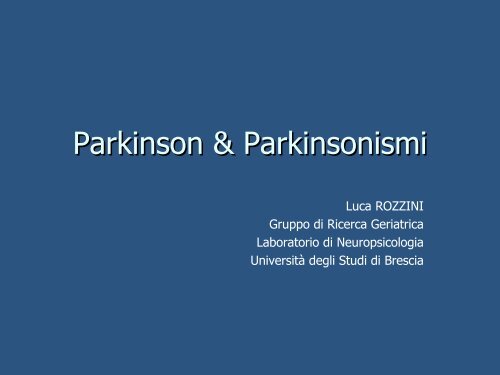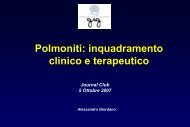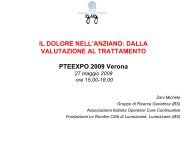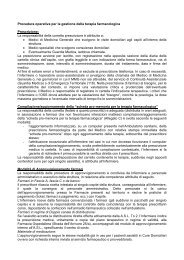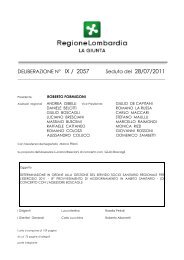Diapositive in formato pdf - GrG
Diapositive in formato pdf - GrG
Diapositive in formato pdf - GrG
Create successful ePaper yourself
Turn your PDF publications into a flip-book with our unique Google optimized e-Paper software.
Park<strong>in</strong>son & Park<strong>in</strong>sonismi<br />
Luca ROZZINI<br />
Gruppo di Ricerca Geriatrica<br />
Laboratorio di Neuropsicologia<br />
Università degli Studi di Brescia
2003. MR, maschio 1931, destrimane<br />
Scolarità: 8 anni<br />
Professione: pasticcere poi assistente edile<br />
Caregiver: vive con la moglie<br />
S<strong>in</strong>tomo d’esordio: ansia da 3 anni<br />
Familiarità per demenza: negativa<br />
Fumo: no<br />
Alcool: adeguato<br />
Terapia: Norvasc ½ cp; Teraprost ½ cp; Elopram 10 gtt;Lexotan 10 gtt.
Motivo della visita ambulatoriale<br />
Deposto deficit cognitivo caratterizzato da<br />
anomie e disturbo di memoria fluttuante,<br />
presente da circa un anno, senza impatto<br />
sulla funzione quotidiana.<br />
S<strong>in</strong>tomatologia ansioso depressiva.<br />
Tre episodi di caduta a terra (<strong>in</strong> bicicletta e<br />
mentre stava camm<strong>in</strong>ando).
Anamnesi patologica remota<br />
Intervento chirurgico di riduzione ernia <strong>in</strong>gu<strong>in</strong>ale.<br />
Pseudoafachia chirurgica OS.<br />
Calcolosi della colecisti.<br />
Ipertrofia prostatica benigna <strong>in</strong> trattamento.<br />
Ipertensione arteriosa sistemica <strong>in</strong> trattamento<br />
farmacologico (recentemente sospeso per<br />
riscontro di bassi valori pressori).<br />
S<strong>in</strong>tomatologia ansioso depressiva.
Valutazione Multidimensionale<br />
MMSE 27/30<br />
Test orologio 9/10<br />
ADAS Cog 12,6/70<br />
CDR 0,5/5<br />
IADL 1/6 funzioni perse<br />
BADL 0/6 funzioni perse<br />
Barthel <strong>in</strong>dex 100/100<br />
T<strong>in</strong>etti scale e.13/16; a.8/12<br />
UPDRS III 12/56<br />
Hach<strong>in</strong>ski 3/19
Valutazione Psicocomportamentale<br />
GDS 10/15<br />
Hamilton ansia 16/48<br />
NPI 35/144<br />
Deliri 3<br />
Alluc<strong>in</strong>azioni 0<br />
Agitazione 2<br />
Depressione 6<br />
Ansia 6<br />
Euforia 0<br />
Apatia 6<br />
Dis<strong>in</strong>ibizione 0<br />
Irritabilità 6<br />
Affaccendamento 4<br />
Insonnia 2
Ricovero <strong>in</strong> Day Hospital
E.O.N.<br />
Stato Mentale<br />
Nervi Cranici<br />
Motilità e Tono<br />
Muscolare<br />
Sensibilità<br />
Andatura e Postura<br />
Funzione Cerebellare<br />
Riflessi Osteo-Tend<strong>in</strong>ei<br />
Riflessi Primitivi<br />
Vigile, psiche lucida, sensorio <strong>in</strong>denne, collaborante, orientato nel tempo e nello<br />
spazio; lievemente rallentata la comprensione verbale; l’espressione verbale è<br />
rallentata e poco fluente per alterato reperimento di vocaboli e difficoltà di mantenere<br />
l’attenzione. Facies sofferente.<br />
Nella norma; MOE nella norma; pupille isocoriche, normoreagenti allo stimolo<br />
lum<strong>in</strong>oso ed all’accomodazione consensuale; riduzione dello sguardo verso l’alto,<br />
ipoacusia; non diplopia, non nistagmo. L<strong>in</strong>gua normoprotrusa. Ipoacusia bilaterale<br />
Non deficit stenico <strong>in</strong> M<strong>in</strong>gazz<strong>in</strong>i ed alle prove segmentarie AS e AI bilateralmente;<br />
motilità f<strong>in</strong>e conservata; sequenze motorie e movimenti alternati <strong>in</strong>denni; tono<br />
muscolare nella norma, trofismo nella norma. Tremore f<strong>in</strong>e attitud<strong>in</strong>ale alle mani<br />
bilateralmente<br />
Nella norma la sensibilità superficiale AI bilateralmente.<br />
Deambulazione possibile senza appoggio;atteggiamento camptocormico e riduzione<br />
dei movimenti pendolari, possibile su punte e talloni, saltello limitato; Romerg<br />
negativo. Buono il controllo dei riflessi posturali.<br />
Prova <strong>in</strong>dice-naso: nella norma ad occhi aperti e chiusi. Prova degli <strong>in</strong>dici <strong>in</strong>denne.<br />
Adiadococ<strong>in</strong>esia assente.<br />
Riflessi normoevocabili agli arti superiori e vivaci agli arti <strong>in</strong>feriori; non Hoffmann, non<br />
Bab<strong>in</strong>ski.<br />
Glabellare esauribile, palmo-mentoniero presente a destra, muso presente; prensione<br />
assente.<br />
S<strong>in</strong>tesi: s<strong>in</strong>drome extrapiramidale con segni di liberazione frontale
RM encefalo<br />
In sede sovraterntoriale vi è una sfumata<br />
iper<strong>in</strong>tensità nelle sequenze T2 e FLAIR nella<br />
sostanza bianca adiacente ai corni frontali riferibile<br />
ad ipoafflusso vascolare cronico. M<strong>in</strong>uta lesione<br />
ischemica cronica iper<strong>in</strong>tensa <strong>in</strong> T2 e FLAIR nella<br />
sostanza bianca sottocorticale fronto-opercolare<br />
s<strong>in</strong>istra.<br />
Diffusa atrofia cortico sottocorticale più evidente a<br />
livello dei lobi temporali e frontali bilateralmente e<br />
consensuale dilatazione del sistema ventricolare.
Altri accertamenti diagnostici<br />
SPET cerebrale di flusso: nella norma<br />
EEG: modesto globale rallentamento della attività<br />
elettrica cerebrale, con alterazioni elettriche di tipo<br />
lento bilaterali.<br />
ECO TSA: nella norma<br />
ABPM: normali i valori di pressione arteriosa sistosistodiastolica con la terapia <strong>in</strong> atto.<br />
Tilt-table test: test positivo per modificazioni<br />
emod<strong>in</strong>amiche, non s<strong>in</strong>tomi con risposta vaso<br />
depressiva vaso vagale
Valutazione Neuropsicologica 2003<br />
Memoria verbale e non verbale<br />
Apprendimento lista di parole normale<br />
Raccont<strong>in</strong>o normale<br />
Figura di Rey recall Abilità visuo-spaziali<br />
patologico<br />
Matrici colorate di Raven Pianificazione spaziale e attenzione<br />
normale<br />
Trail Mak<strong>in</strong>g A normale<br />
Trail Mak<strong>in</strong>g B L<strong>in</strong>guaggio<br />
normale<br />
Fluenza per lettera normale<br />
Fluenza per categoria Funzioni esecutive-visuo costruttive<br />
normale<br />
Clock-test normale<br />
Figura di Rey copia patologico
Petersen et al. Arch Neurol, 1999<br />
(i) presence of a subjective memory compla<strong>in</strong>t;<br />
(ii) preserved general <strong>in</strong>tellectual function<strong>in</strong>g (as<br />
estimated <strong>in</strong> this study by performance on a<br />
vocabulary test);<br />
(iii) demonstration of a memory impairment by<br />
cognitive test<strong>in</strong>g;<br />
(iv) <strong>in</strong>tact ability to perform activities of daily<br />
liv<strong>in</strong>g;<br />
(v) absence of dementia.
Revised Criteria for Mild Cognitive Impairment:<br />
Validation with<strong>in</strong> a Longitud<strong>in</strong>al Population Study<br />
Artero, Petersen, Touchon, Ritchie<br />
Dement Geriatr Cogn Disord 2006;22:465–470<br />
(i) presence of a cognitive compla<strong>in</strong>t from either<br />
the subject and/or a family member;<br />
(ii) absence of dementia;<br />
(iii) change from normal function<strong>in</strong>g;<br />
(iv) decl<strong>in</strong>e <strong>in</strong> any area of cognitive function<strong>in</strong>g;<br />
(v) preserved overall general function<strong>in</strong>g but<br />
possibly with <strong>in</strong>creas<strong>in</strong>g difficulty <strong>in</strong> the<br />
performance of activities of daily liv<strong>in</strong>g.
Dimissione<br />
Decadimento cognitivo lieve <strong>in</strong> paziente con<br />
s<strong>in</strong>tomatologia extrapiramidale,<br />
disautonomia ed encefalopatia vascolare<br />
Ipertensione arteriosa sistemica<br />
Ipertrofia prostatica<br />
Disturbo d’adattamento con umore depresso
Terapia alla dimissione<br />
S<strong>in</strong>emet cr 25/100 1cp x 3 die<br />
Motilium 10 ml x 3 die<br />
Norvasc ½ cp<br />
Teraprost ½ cp<br />
Elopram 10 gtt<br />
Lexotan 10 gtt
Valutazione Multidimensionale 2004<br />
MMSE 27/30 26/30<br />
Test orologio 9/10 9/10<br />
ADAS Cog 12,6/70 7/70<br />
CDR 0,5/5 0,5/5<br />
IADL 1/6 funzioni perse 1/6<br />
BADL 0/6 funzioni perse 0/6<br />
Barthel <strong>in</strong>dex 100/100 100/100<br />
T<strong>in</strong>etti scale 21/28 20/28<br />
UPDRS III 12/56 18/56<br />
Hach<strong>in</strong>ski 3/19
Valutazione Neuropsicologica 2004<br />
Memoria verbale e non verbale<br />
Apprendimento lista di parole normale normale<br />
Raccont<strong>in</strong>o normale normale<br />
Figura di Rey recall Funzioni superiori<br />
patologico ai limiti<br />
Matrici colorate di Raven Pianificazione spaziale e attenzione<br />
normale normale<br />
Trail Mak<strong>in</strong>g A normale patologico<br />
Trail Mak<strong>in</strong>g B L<strong>in</strong>guaggio<br />
normale patologico<br />
Fluenza per lettera normale patologico<br />
Fluenza per categoria Funzioni esecutive-visuo costruttive<br />
normale normale<br />
Clock-test normale normale<br />
Figura di Rey copia patologico patologico
Valutazione Psicocomportamentale<br />
GDS 10/15 12/15<br />
Hamilton ansia 16/48 14/48<br />
NPI 35/144 18/144<br />
Deliri 3 0<br />
Alluc<strong>in</strong>azioni 0 0<br />
Agitazione 2 2<br />
Depressione 6 4<br />
Ansia 6 4<br />
Euforia 0 0<br />
Apatia 6 4<br />
Dis<strong>in</strong>ibizione 0 0<br />
Irritabilità 6 2<br />
Affaccendamento 4 0<br />
Insonnia 2 0
Ricovero presso “Ambulatorio<br />
per la depressione geriatrica”.<br />
2005
Motivo della visita: relazione diagnostica<br />
Il paziente è <strong>in</strong> carico presso l’ambulatorio<br />
della depressione geriatrica per s<strong>in</strong>tomi<br />
ansiosi e depressivi (soprattutto apatia)<br />
esorditi circa 7 anni fa e peggiorati negli<br />
ultimi 2 anni, quando è comparso anche<br />
rallentamento nella deambulazione e piccoli<br />
passi, postura ricurva.
EON: ipertono plastico agli arti superiori,<br />
segno della glabella e muso positivi, lieve<br />
ipermetria e as<strong>in</strong>ergia alla prova tallone<br />
g<strong>in</strong>occhio, ipotonia agli arti <strong>in</strong>feriori,<br />
deambulazione a piccoli passi strascicati,<br />
postura camptocormica, si gira su se stesso<br />
a passi discont<strong>in</strong>ui con 3-4 passi.<br />
Ipotensione ortostatica. (170/100 <strong>in</strong> cl<strong>in</strong>o;<br />
110/80 <strong>in</strong> orto immediato, 120/80 dopo 1 e<br />
3 m<strong>in</strong>uti.
Valutazione Neuropsicologica
Risonanza magnetica ad alta def<strong>in</strong>izione<br />
Atrofia corticale<br />
frontotemporale e<br />
parietale bilaterale,<br />
dx>sx, <strong>in</strong> assenza di<br />
danno vascolare<br />
sottocorticale.
Risonanza magnetica ad alta def<strong>in</strong>izione<br />
Atrofia ippocampale con<br />
scala qualitativa.<br />
Lieve atrofia temporale<br />
mesiale:2/4 alla scala di<br />
valutazione visiva di<br />
Sceltens (v.n.0-1,<br />
patologici 2-4)
Atrofia ippocampale con volumetria:la volumetria<br />
dell’ippocampo (vol <strong>in</strong> cc normalizzato per volume <strong>in</strong>tracranico<br />
<strong>in</strong> litri) è nella norma (25-50 percentile)
Risonanza magnetica ad alta def<strong>in</strong>izione<br />
Atrofia mesencefalica.<br />
La misura l<strong>in</strong>eare del diametro antero<br />
posteriore del mesencefalo è di<br />
16,5mm (v.n. medi 18 mm; range 17-<br />
20).
Diagnosi<br />
Il quadro complessivo è <strong>in</strong>dicativo di atrofia<br />
multisistemica di tipo cerebellare (MSA P). Si tratta di<br />
una malattia neurodegenerativa causata dall’accumulo<br />
di una prote<strong>in</strong>a neurotossica (alfa s<strong>in</strong>ucle<strong>in</strong>a) e<br />
caratterizzata dalla comb<strong>in</strong>azione di park<strong>in</strong>sonismo,<br />
segni e s<strong>in</strong>tomi autonomici variabili e segni cerebellari<br />
e piramidali. Il decorso è progressivo ed <strong>in</strong>validante.<br />
Non vi è terapia specifica e il trattamento è<br />
s<strong>in</strong>tomatico (la risposta del park<strong>in</strong>sonismo alla L-dopa<br />
è generalmente <strong>in</strong>completa e transitoria).
Degenerazione di<br />
fibre trasverse del<br />
ponte con risparmio<br />
dei fasci piramidali
Fasi avanzate
2006, luglio<br />
Stato Mentale<br />
Nervi Cranici<br />
Motilità e Tono<br />
Muscolare<br />
Sensibilità<br />
Andatura e Postura<br />
Funzione Cerebellare<br />
Riflessi Osteo-Tend<strong>in</strong>ei<br />
Riflessi Primitivi<br />
Vigile, psiche lucida, sensorio <strong>in</strong>denne, collaborante, parzialmente orientato nel<br />
tempo e nello spazio; MMSE 16/30<br />
Nella norma; MOE nella norma con riduzione di movimenti di verticalità; pupille<br />
isocoriche, normoreagenti allo stimolo lum<strong>in</strong>oso ed all’accomodazione consensuale;<br />
riduzione dello sguardo verso l’alto, ipoacusia; non diplopia, non nistagmo. L<strong>in</strong>gua<br />
normoprotrusa. Ipoacusia bilaterale<br />
Non deficit stenico <strong>in</strong> M<strong>in</strong>gazz<strong>in</strong>i ed alle prove segmentarie AS e AI bilateralmente;<br />
lieve ipertono plastico agli arti superiori dx>sx; sequenze motorie e movimenti<br />
alternati rallentati; trofismo nella norma. Tremore f<strong>in</strong>e attitud<strong>in</strong>ale alle mani<br />
bilateralmente<br />
Nella norma la sensibilità superficiale AI bilateralmente.<br />
Deambulazione impossibile senza aiuto; stazione eretta: camptocormico il paziente<br />
potrebbe cadere se non sorretto dall’esam<strong>in</strong>atore.<br />
Prova <strong>in</strong>dice-naso: dismetria ad occhi aperti e chiusi. Adiadococ<strong>in</strong>esia presente.<br />
Riflessi vivaci agli arti superiori e agli arti <strong>in</strong>feriori; non Hoffmann, Bab<strong>in</strong>ski a destra.<br />
Glabellare esauribile, palmo-mentoniero bilaterale, muso presente; prensione<br />
assente.<br />
S<strong>in</strong>tesi: s<strong>in</strong>drome piramido- extrapiramidale con segni cerebellari e di liberazione frontale
Multiple System Atrophy<br />
Def<strong>in</strong>ition<br />
The concept of multiple system atrophy (MSA) as<br />
a unitary diagnosis encompass<strong>in</strong>g several cl<strong>in</strong>ical<br />
syndromes has a long history.<br />
In 1996 and 1998, the Consensus Committees<br />
represent<strong>in</strong>g the American Autonomic Society and<br />
the American Academy of Neurology def<strong>in</strong>ed MSA<br />
as a sporadic, progressive, neurodegenerative<br />
disease of undeterm<strong>in</strong>ed etiology, characterized by<br />
extrapyramidal, pyramidal, cerebellar, and<br />
autonomic dysfunction <strong>in</strong> any comb<strong>in</strong>ation.
Def<strong>in</strong>ition<br />
When autonomic failure predom<strong>in</strong>ates, MSA<br />
sometimes is termed Shy-Drager syndrome. syndrome.<br />
When extrapyramidal features predom<strong>in</strong>ate<br />
(80%), the term striatonigral degeneration or or<br />
MSA-P MSA-P sometimes is used. (SND)<br />
When cerebellar features predom<strong>in</strong>ate (20%),<br />
MSA sometimes is termed sporadic<br />
olivopontocerebellar atrophy atrophy or or MSA-C. MSA-C. (OPCA (OPCA )<br />
)
Epidemiology<br />
Incidence 0,6 per 100 000<br />
>50 ys: 3 per 100 000<br />
Prevalence 1,9-4,9 per 100 000<br />
Sex (m:f) 1,3: 1,0 (3:1)<br />
Age (range) 33-78 (mean 54,3)<br />
Mean survival 6-9 ys<br />
(bronchopneumonia 48%; sudden death 21%)
Pathophysiology<br />
Progressive loss of neuronal and oligodendroglial cells <strong>in</strong><br />
numerous sites <strong>in</strong> the central nervous system correlated<br />
with cl<strong>in</strong>ical symptoms.<br />
No evidence of a genetic etiology.<br />
Oligodendroglial cytoplasmic <strong>in</strong>clusions <strong>in</strong>dicates that<br />
damage is primarily <strong>in</strong> the white matter.<br />
In addition to the GCIs, extensive myel<strong>in</strong> degeneration<br />
occurs <strong>in</strong> the bra<strong>in</strong>.<br />
Chronic alterations <strong>in</strong> glial cells may impair trophic function<br />
between oligodendrocytes and axons and cause secondary<br />
neuronal damage.
Glial Ctytoplamic Inclusions<br />
(GCIs)<br />
Unique biological hallmark of MSA<br />
Multilayered tubular filaments conta<strong>in</strong><strong>in</strong>g ubiquit<strong>in</strong>,<br />
tau (classical cytoskeletal antigens) and α-<br />
synucle<strong>in</strong> (presynaptic prote<strong>in</strong>)<br />
α-synucle<strong>in</strong> -synucle<strong>in</strong> accumulation <strong>in</strong> GCIs plays a central<br />
part <strong>in</strong> MSA, PD and LBD<br />
Inability of oligodendrocytes to degrade α-<br />
synucle<strong>in</strong> normally produced or ectopic expression
CNS sites damaged<br />
Basal Ganglia (motor neostriatum)<br />
Putamen (caudal, dorsolateral); SN pars compacta<br />
Motor cortex (primary and supplementary)<br />
Olivopontocerebellar system<br />
Basis pontis, transverse pontocerebellar fibers, middle cerebellar<br />
peduncles<br />
Dorsal motor nucleus of the vagus nerve<br />
Locus Coeruleus<br />
Cathecolam<strong>in</strong>ergic neurons of ventrolateral medulla<br />
Pontomedullary reticular formation<br />
Parasympathetic preganglionic nuclei of the sp<strong>in</strong>al cord (Onuf’s<br />
nucleus, S2-S3, <strong>in</strong>ferior <strong>in</strong>termediolateral nucleus, S3-S4)<br />
Sympathetic preganglionic neurons <strong>in</strong> the <strong>in</strong>termediolateral column of<br />
the sp<strong>in</strong>al cord
Autonomic dysfunction<br />
Genitour<strong>in</strong>ary (41-47% - 97%)<br />
Ur<strong>in</strong>ary <strong>in</strong>cont<strong>in</strong>ence (frequency, frequency, urgency)<br />
Preganglionic cell loss <strong>in</strong> sp<strong>in</strong>al cord (<strong>in</strong>termediolateral cell<br />
columns)<br />
Related to detrusor hyperreflexia caused ma<strong>in</strong>ly by loss of<br />
<strong>in</strong>hibitory <strong>in</strong>put to pont<strong>in</strong>e micturition center (rather than<br />
to external urethral sph<strong>in</strong>cter denervation alone)<br />
Ur<strong>in</strong>ary retention (<strong>in</strong>complete bladder empty<strong>in</strong>g)<br />
Sacral <strong>in</strong>termediolateral cell columns (related to detrusor<br />
atonia)<br />
Erectile dysfunction or impotence
Autonomic dysfunction<br />
Orthostatic hypotension (68%)<br />
Primary preganglionic damage of<br />
<strong>in</strong>termediolateral cell columns (baroreflex<br />
impairment and debuffer<strong>in</strong>g)<br />
Syncope (51% at least once, 15% recurrent)<br />
Post prandial hypotension<br />
Sup<strong>in</strong>e hypertension with orthostatic<br />
hypotension (60%)
Park<strong>in</strong>sonism (46% - 91%)<br />
GCIs <strong>in</strong> basal ganglia<br />
Ak<strong>in</strong>esia and Rigidity<br />
Putamen, Globus Pallidus<br />
Postural Tremor or at rest (29%)<br />
Postural Instability (early, unusual recurrent falls)<br />
Orofacial or craniocervical dystonia associated with<br />
quiver<strong>in</strong>g, high-pitched dysathria<br />
Poor response to levodopa (28% good response<br />
early <strong>in</strong> the disease especially <strong>in</strong> younger patients,<br />
only 13% ma<strong>in</strong>tened this response)<br />
Striatal cell loss. Loss of D1and D2 receptors <strong>in</strong><br />
Striatum or impaired functional coupl<strong>in</strong>g of D1 and D2<br />
receptors
Cerebellar Dysfunction (5% - 54%)<br />
Cell loss <strong>in</strong> <strong>in</strong>ferior olives, pont<strong>in</strong>e nuclei, and cerebellar<br />
cortex<br />
Gait ataxia (wide-based stance with<br />
steps of irregular length and direction)<br />
Limb k<strong>in</strong>etic ataxia<br />
Ataxic dysartrhya<br />
Susta<strong>in</strong>ed gaze-evoked nystagmus
Pyramidal signs (49%)<br />
Pyramidal tract demyel<strong>in</strong>ation<br />
Extensor plantar response<br />
Hyper-reflexia
Other symptoms based on mixed<br />
dysfunction<br />
Laryngeal Stridor - Vocal cord paralysis<br />
Severe cell loss <strong>in</strong> nucleus ambiguus or<br />
biochemical defect caus<strong>in</strong>g atrophy <strong>in</strong><br />
posterior cricoarytenoid muscles<br />
Sleep apnea<br />
A neurogenic and abstructive mixed form
Cl<strong>in</strong>ical Presentation<br />
Cl<strong>in</strong>ical doma<strong>in</strong>s<br />
Autonomic and<br />
Ur<strong>in</strong>ary disfunction<br />
Park<strong>in</strong>sonism<br />
Cerebellar<br />
Dysfunction<br />
Corticosp<strong>in</strong>al tract<br />
Dysfunction<br />
Initial symptoms<br />
(%)<br />
41-74<br />
46<br />
5<br />
-<br />
Incidence dur<strong>in</strong>g<br />
lifetime (%)<br />
97 (68 orthostatic<br />
hypotension)<br />
87-91<br />
54<br />
49
Consensus statement on the<br />
diagnosis of MSA<br />
Gilman et al., J Neurol Sci 1999<br />
Developed diagnostic criteria based on 4 4<br />
cl<strong>in</strong>ical cl<strong>in</strong>ical doma<strong>in</strong>s. doma<strong>in</strong>s.<br />
These f<strong>in</strong>d<strong>in</strong>gs allowed<br />
subclassification of patients <strong>in</strong>to different<br />
levels of diagnostic certa<strong>in</strong>ty such as<br />
possible, probable, and and def<strong>in</strong>ite. def<strong>in</strong>ite.<br />
The<br />
conference also recommended that MSA<br />
be subdivided <strong>in</strong>to 2 categories based on<br />
the prevalent neurosystem <strong>in</strong>volved.
Autonomic and ur<strong>in</strong>ary dysfunction<br />
Features<br />
Orthostatic hypotension (by 20 mmHg systolic or 10<br />
mmHg diastolic)<br />
Ur<strong>in</strong>ary <strong>in</strong>cont<strong>in</strong>ence or <strong>in</strong>complete bladder empty<strong>in</strong>g<br />
Criteria<br />
Orthostatic falls <strong>in</strong> blood pressure (by 30 mmHg<br />
systolic or 15 mmHg dyastolic) or ur<strong>in</strong>ary <strong>in</strong>cont<strong>in</strong>ence<br />
(persistent, <strong>in</strong>voluntary partial or total bladder<br />
emty<strong>in</strong>g, accompa<strong>in</strong>ed by erectile dysfunction <strong>in</strong> men)<br />
or both
Park<strong>in</strong>sonism<br />
Features<br />
Bradyk<strong>in</strong>esia (slowness of voluntary movement with<br />
progressive reduction <strong>in</strong> speed and amplitude dur<strong>in</strong>g<br />
repetitive actions)<br />
Rigidity<br />
Postural <strong>in</strong>stability (not caused by primary visual,<br />
vestibular, cerebellar or propioceptive dysfunction)<br />
Tremor (postural, rest<strong>in</strong>g or both)<br />
Criteria<br />
Bradyk<strong>in</strong>esia plus at least one of features 2-4
Cerebellar Dysfunction<br />
Features<br />
Gait ataxia (wide based stance with steps of<br />
irregular lenght and direction)<br />
Ataxis dysarthria<br />
Limb ataxia<br />
Susta<strong>in</strong>ed gaze-evoked nystagmus<br />
Criteria<br />
Gait ataxia plus at least one of features 2-4
Corticosp<strong>in</strong>al tract dysfunction<br />
Features<br />
Extensor plantar responses with hyperhyperreflexia Criteria<br />
No corticosp<strong>in</strong>al tract features are used <strong>in</strong><br />
def<strong>in</strong><strong>in</strong>g the diagnosis of MSA
Consensus statement:<br />
diagnostic categories of MSA<br />
Possible MSA<br />
One criterion plus two features from separate other doma<strong>in</strong>s<br />
When criterion is park<strong>in</strong>sonism, a poor levodopa response qualifies<br />
as one feature (hence only one additional feature required)<br />
Probable MSA<br />
Criterion for autonomic failure and ur<strong>in</strong>ary dysfunction plus poorly<br />
levodopa-responsive park<strong>in</strong>sonism or cerebellar dysfunction<br />
Def<strong>in</strong>ite MSA<br />
Pathologically confirmed by presence of high density of GCIs <strong>in</strong><br />
association with degenerative changes <strong>in</strong> nigrostriatal and<br />
olivopontocerebellar pathways
Imag<strong>in</strong>g<br />
MRI (olivopontocerebellar and putam<strong>in</strong>al atrophy) To<br />
differentiate from cerebellar ataxia, PD, PSP,CVD<br />
T2 weighted images. images.<br />
Hyper<strong>in</strong>tensities with<strong>in</strong> the pons<br />
and the middle cerebellar peduncles (hot cross bun);<br />
putam<strong>in</strong>al hypo<strong>in</strong>tensity associated with a slit-like<br />
hyper<strong>in</strong>tensity band lateral to the putamen<br />
Diffusion weighted images. images.<br />
High putam<strong>in</strong>al regional<br />
apparent diffusion coefficients <strong>in</strong> MSA-P reflect ongo<strong>in</strong>g<br />
striatal degeneration.<br />
MRI based volumetry. volumetry.<br />
Significant reductions <strong>in</strong> mean<br />
striatal and bra<strong>in</strong>stem volumes. MSA-C and MSA-P also<br />
have a low cerebellar volume.
Imag<strong>in</strong>g<br />
Functional imag<strong>in</strong>g<br />
Recently, SPECT and PET ligands that enable<br />
study of cardiac sympathetic <strong>in</strong>nervation have<br />
become available. They seems to be helpful<br />
tools that may support an early cl<strong>in</strong>ical<br />
diagnosis of MSA, discrim<strong>in</strong>at<strong>in</strong>g from PD and<br />
pure autonomic failure
Treatment<br />
Park<strong>in</strong>sonism<br />
Levodopa (plus decarboxylase <strong>in</strong>hibitor) up to 1000<br />
mg/day (30-70%; decl<strong>in</strong>es after few ys; disk<strong>in</strong>esias)<br />
Dopam<strong>in</strong>e agonist (bromocript<strong>in</strong>e and lisuride not<br />
efficacy)<br />
Amantad<strong>in</strong>e (anecdotal benefit <strong>in</strong> s<strong>in</strong>gle case)<br />
Antichol<strong>in</strong>ergics useful for hypersalivation<br />
Medial pallidotomy (not improve motor disturbances)<br />
Bilateral subthalamic nucleus high-frequency<br />
stimulation (beneficial <strong>in</strong> four patients)
Treatment<br />
Orthostatic hypotension (to treat when disabl<strong>in</strong>g)<br />
Avoid<strong>in</strong>g aggravat<strong>in</strong>g factors (large meal, alcohol, exposure to warm<br />
environment)<br />
Wear<strong>in</strong>g of elastic stock<strong>in</strong>gs<br />
Head-up tilt of bed at night<br />
Increase salt <strong>in</strong>take<br />
Fludrocortisone and desmopress<strong>in</strong> (>plasma volume,
Treatment<br />
Genitour<strong>in</strong>ary dysfunction<br />
Desmopress<strong>in</strong> at night for nicturia (tablets100-400 ug)<br />
Peripherally act<strong>in</strong>g antichol<strong>in</strong>egic drugs (<strong>in</strong>duce retention)<br />
Sildenafil for erectile dysfunction (exacerbate OH)<br />
Other therapies<br />
Physiotherapy<br />
Speech therapy<br />
Occupational therapy and psychological support<br />
Wheelchair?<br />
Tracheostomy?<br />
Nasogastric o PEG?
Anatomical evidence for cerebellar and basal<br />
ganglia <strong>in</strong>volvement <strong>in</strong> higer cognitive function.<br />
Kim et al. Science. 1994;265:949-951<br />
Evidence for cerebellar-frontal subsystem changes<br />
<strong>in</strong> children treated with <strong>in</strong>trathecal chemoterapy<br />
for leukemia.<br />
Lesnik et al. Arch Neurol. 1998;55:1561-1568
Park<strong>in</strong>sonian signs <strong>in</strong> subjects with mild cognitive impairment<br />
Barbara Vic<strong>in</strong>i Chilovi, Luca Rozz<strong>in</strong>i, Alessandro Padovani<br />
Neurology 2006;67;182-183<br />
To the Editor: We read the article by Boyle et al. with <strong>in</strong>terest.<br />
The authors report that mild cognitive impairment (MCI) is accompanied by<br />
extrapyramidal signs (EPS) that are related to the severity and type of<br />
cognitive impairment <strong>in</strong>dependent of vascular risk factors.<br />
The association between mild park<strong>in</strong>sonian signs (MPS) and MCI has<br />
previously been described, specifically the relationship between MPS and the<br />
amnestic type (aMCI).Furthermore, rigidity rather than tremor or bradyk<strong>in</strong>esia<br />
were most strongly associated with MCI.<br />
These f<strong>in</strong>d<strong>in</strong>gs confirm the assumption that MCI is associated with<br />
park<strong>in</strong>sonian signs, the severity of which is related to the severity and<br />
differential pattern of both cognitive and behavioral dysfunctions. The<br />
association between EPS and specific behavioral disturbances <strong>in</strong>cluded <strong>in</strong> the<br />
core features of DLB suggests that Lewy body pathology might be the major<br />
contribut<strong>in</strong>g factor to both EPS and BPSD.<br />
In addition, neuropsychological data showed that MCI subjects had a greater<br />
deterioration of visuospatial skills primarily compromised <strong>in</strong> DLB. Further<br />
studies are needed to follow up those MCI patients with EPS to determ<strong>in</strong>e<br />
whether they have a more rapid progression to dementia.
Park<strong>in</strong>sonian signs and psycho-behavioural symptoms<br />
<strong>in</strong> subjects with Mild Cognitive Impairment.<br />
Background: Mild Cognitive Impairment (MCI) may be<br />
accompanied by extrapyramidal signs (EPS), which are<br />
related to the severity and type of cognitive impairment.<br />
Moreover mild park<strong>in</strong>sonian signs are mostly associated<br />
with MCI of the amnestic type (aMCI). It has been<br />
hypothesised that MCI and EPS may share similar<br />
pathogenesis though it is unknown whether this <strong>in</strong>volves<br />
Alzheimer-type pathology, Lewy bodies or vascular changes<br />
<strong>in</strong> the basal ganglia.<br />
Aim of the study: further elucidate the relationship<br />
between MCI and EPS and to characterize the<br />
neuropsychiatric features of MCI patients with EPS.
Table 1. Cl<strong>in</strong>ical and socio-demographic characteristics of two groups of 132 MCI<br />
subjects with different severity of extrapyramidal symptoms (UPDRS part III).<br />
MCI without EPS<br />
N° 97<br />
MCI with moderate EPS<br />
N° 35<br />
Mean SD % Mean SD % P<br />
Age (ys) 71,2 7,7 72,4 7,3 NS<br />
Sex (female) 63,9 68,6 NS<br />
Education (ys) 7,9 3,8 7,3 3,2 NS<br />
Comorbility ^ 2,1 1,7 1,9 1,6 NS<br />
Drugs (n) 2,7 2,1 2,6 1,7 NS<br />
APO -E ε4 § 42,7<br />
40,6 NS<br />
WML # 23,3<br />
25 NS<br />
Vascular <strong>in</strong>dex ç 42,3<br />
34,3 NS<br />
CDR total 0,5 0,1 0,5 0,1 NS<br />
MMSE 26,8 1,9 26,7 1,7 NS<br />
ADAS -Cog total score 7,9 4,1 9,7 4,7 .03<br />
ADAS -Cog memory items 16,1 4,1 17,2 3,8 NS<br />
ADAS -Cog without memory items 3,5 2,5 4,6 3,1 .05<br />
Short story (Novelli) 7,5 3,3 8,5 4,9 NS<br />
Rey’s figure copy 28,1 7,3 26,4 8,6 NS<br />
Barthel <strong>in</strong>dex 98,5 3,6 98,1 3,9 NS<br />
BADL (functions lost) 0,2 0,4 0,2 0,4 NS<br />
% of subject s with > 1 functions lost 15,5 20 NS<br />
IADL (functions lost) 0,4 0,8 0,5 0,7 NS<br />
% of subjects with > 1 functions lost 27,8 34,3 NS<br />
T<strong>in</strong>etti scale 27,5 1,5 25,6 2,8 .000<br />
UPDRS -part III 1,1 1,7 9,3 7,2 .000<br />
Neuropsychiatric Inventory 12,4 11, 5 16,3 11,5 NS<br />
Geriatric Depression Scale (15 items) 4,5 3,2 5,3 3,7 NS<br />
Hamilton anxiety scale 9,3 6,7 11,1 6,2 NS
Table 2. Neuropsychiatric characteristics (NPI subitems) of two groups of 132<br />
MCI subjects with different severity of extrapyramidal symptoms (UPDRS part<br />
III).<br />
MCI without<br />
EPS<br />
N° 97<br />
MCI with<br />
moderate EPS<br />
N° 35<br />
% % P<br />
Delusion 10,3 17,1 NS<br />
Halluc<strong>in</strong>ation 5,2 11,4 NS<br />
Agitation 25,8 40 NS<br />
Depression 39,2 57,1 .05<br />
Anxiety 35,1 54,3 .04<br />
Euphoria 8,2 11,4 NS<br />
Apathy 24,7 42,9 .04<br />
Dis<strong>in</strong>ibition 2,1 2,9 NS<br />
Irritability 47,4 45,7 NS<br />
Aberrant motor behaviour<br />
3,1 11,4 NS<br />
Sleep disturbances 32 54,3 .02<br />
Eat<strong>in</strong>g disturbances 12,4 2,9 NS
Conclusion: data corroborate the<br />
assumption that MCI may be associated<br />
with park<strong>in</strong>sonian signs, whose severity is<br />
related to the severity of cognitive<br />
impairment, <strong>in</strong> particular of non memory<br />
functions, and to a differential pattern of<br />
psycho-behavioural symptoms.


